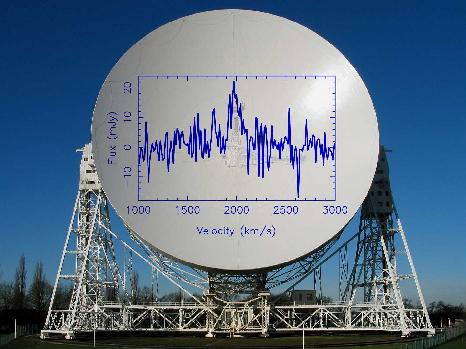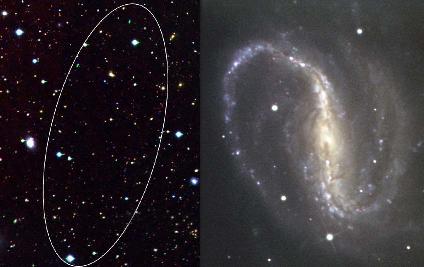In the Virgo cluster of galaxies they found an object, which has the working nameVIRGOHI21, with a mass of hydrogen atoms of two hundred million times the mass of the Sun (2 108 Mo), which is invisible on deep images in visible light. The Virgo cluster is a large group of galaxies about 50 million light years (16 Mpc) away. An astronomer from Paris Observatory (GEPI) participated in mapping the object with the Arecibo radio telescope, which confirmed the initial Lovell telescope detection (see Figure 1) with better sensitivity and with a smaller beam size, which allowed an estimate of its size, about 50 thousand light years (16 kpc). Spectra taken at different positions in the object shows that it rotates with the speed of a fairly massive galaxy. No neutral hydrogen was detected in the mapping with the Very Large Array interferometer, but strong solar radio interference made the detection of extended gas clouds impossible.

It is 500 times more massive than could be accounted for by the observed hydrogen atoms alone. Its total mass is of order of a hundred billion solar masses (1011 Mo). If it were an ordinary galaxy, then it should be quite bright (of about the 12th magnitude — see Figure 2) and would be visible with a good amateur telescope.

Similar objects that have previously been discovered have since turned out to contain stars when studied with high-powered optical telescopes. Others have been found to be the remnants of two galaxies colliding. However, when the scientists studied the area of VIRGOHI21 in question using the Isaac Newton Optical Telescope at La Palma (Spain), they found no visible trace of any stars down to a surface brightness level of 27.5 magnitudes per square arcsecond in the blue, and no nearby galaxies that would suggest a collision. The astronomers first took observations of the dark object back in 2000 and it has taken almost five years to rule out all the other possible explanations. It appears to be the first dark galaxy ever detected. Astronomers have been measuring the way in which stars and galaxies move for many years. These measurements indicate that there must be far more matter in the Universe than can be accounted for by the visible light we see. This .dark matter. still holds many mysteries for astronomers - is it well mixed up amongst the stars, or is it separate from the stars ? Another puzzle is that the current ideas about how galaxies form predict that there should be many more galaxies in the Universe than are visible to us. So, these two ideas - dark matter and the lack of galaxies - have led some astronomers to predict that there must be unseen ’dark’ galaxies hidden in the Universe. Finding a dark matter galaxy is an important breakthrough because, according to cosmological models, dark matter is five times more abundant than the ordinary (baryonic) matter that makes up everything we can see and touch. The presence of dark matter in the Universe can be inferred by looking at the rotation of galaxies and measuring how fast their visible components are moving. The amount of matter in a galaxy dictates the gravitational force needed to hold it together. Astronomers have seen galaxies where the material is moving so fast that they should fly apart . As they don’t, there must be a stronger gravitational force acting than can be accounted for using visible matter. This has led astronomers to believe that there is more matter unseen. The mass of this ’dark matter’ can be calculated from the gravitational force that must be acting to hold the galaxy together. Dark galaxies are thought to form when the density of matter in a galaxy is too low to create the conditions for star formation. The observations of VIRGOHI21 may have other explanations, but they are consistent with the hydrogen being in a flat disc of rotating material — which is what is seen in ordinary spiral galaxies. The team hopes to continue their observations to probe the hidden extent of the Universe. Of particular interest to them are the large, sensitive and complete surveys of cold hydrogen gas that have recently been started with the seven-beam ALFA receiver system at the Arecibo radio telescope, as well as a deeper search for hydrogen gas with large radio interferometers in VIRGOHI21.
